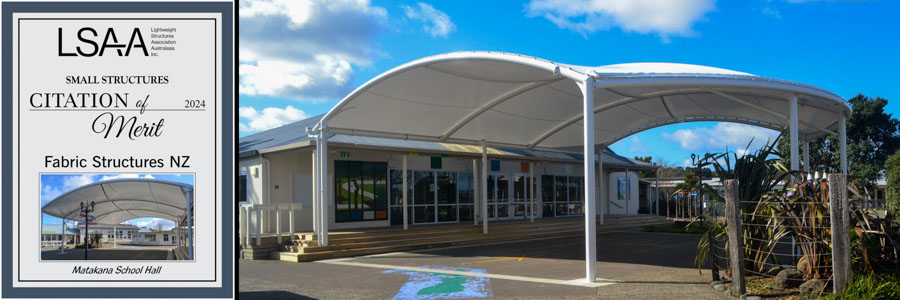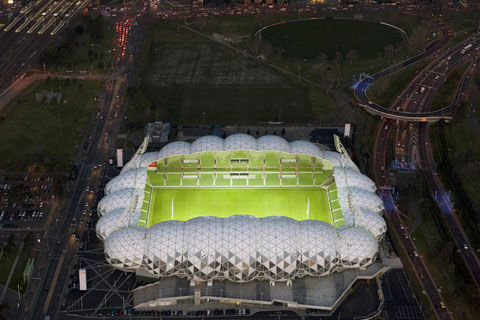Matakana School Canopy Project Description:
Matakana School aimed to enhance its usable exterior space by creating a sheltered area that could be utilized by staff and students throughout the year. The shelter was designed to provide protection from both the sun and rain, functioning as an external extension to the existing school hall. This canopy extension is part of the school’s ongoing efforts to improve facilities and support educational programs. The project is a key element of a broader strategy to upgrade the school's infrastructure, which also includes weatherproofing over 70% of the existing buildings. This initiative reflects the school's commitment to creating a supportive learning environment, ensuring that students have access to quality outdoor and indoor spaces for various activities.
Matakana School Canopy - Design, Fabrication, Installation Brief
Matakana School sought to expand its usable exterior space by adding a large-span canopy to the existing covered deck of the school hall. They needed a structure that covered approximately 13.3 meters by 14.2 meters, or 177 square meters, to extend over the existing court. This space would serve multiple purposes, including outdoor assemblies, sports, general play, and more, requiring the design to be highly versatile.
In response to the design brief, we proposed an elegant solution that seamlessly integrated with the school’s aesthetic. The design featured a curved front member, which not only imparted a feeling of elegance but also maximized the usable space beneath the canopy. The choice of high-quality fabric materials ensured durability and weather resistance, providing year-round protection from sun and rain. Our focus on structural elegance and functionality led to a canopy that not only met the school's requirements but also enhanced the overall visual appeal of the campus.
By carefully considering the aesthetic integration with the existing school architecture, we created a cohesive extension of the hall. This design not only fulfilled the practical needs for a versatile, sheltered outdoor space but also contributed positively to the school's environment. The result was a well-integrated, functional, and visually appealing canopy that significantly enhanced the school's facilities and supported its educational programs.Matakana School Canopy - Structural Systems
The structural system for the Matakana School canopy was designed with an emphasis on robustness and aesthetics, ensuring it met both the functional requirements and the specific site conditions. The canopy covers an area of approximately 13.3 meters by 14.2 meters, providing 177 square meters of versatile, sheltered space.
To achieve this, a tensile fabric structure was utilised, chosen for its strength, lightweight structure, and flexibility. The fabric material was selected for its durability and ability to withstand New Zealand’s variable weather conditions, which include strong winds and heavy rain. The canopy's structure is anchored by steel supports, ensuring stability and the capacity to handle significant loads.
Design considerations included accounting for live loads from wind and rain. The canopy’s curved front member was a functional choice, facilitating efficient drainage and reducing debris accumulation. Ground conditions required careful assessment, involving soil tests to determine the bearing capacity and design suitable foundations. The site was prepared to accommodate the loads transferred from the canopy, ensuring stability and longevity.
The geometric form of the canopy aimed to maximize usable space while maintaining a visually appealing shape. The curved front member adds elegance and increases headroom beneath the canopy. Additionally, a slight slope was incorporated to facilitate water runoff and prevent pooling on the fabric surface.
The design process involved initial concept development, structural analysis, and iterative testing using computer-aided design (CAD) software. Various load scenarios were simulated, and the final design was selected based on its performance and ability to meet the aesthetic and functional requirements outlined by the school.
The chosen design successfully balances form and function, providing a durable, weather-resistant shelter that enhances the school's outdoor facilities. Integration with the existing school hall was achieved through careful planning and precise engineering, ensuring the canopy fits seamlessly with existing structures while adding value to the school environment. This project demonstrates the effective application of tensile fabric structures in educational settings, offering a versatile and aesthetically pleasing solution that meets the specific needs of Matakana School.
Matakana School Canopy - Materials
The project utilized a combination of materials carefully chosen for their durability, aesthetic qualities, and suitability for the structural demands of the design.
The primary material used for the fabric structure was Serge Ferrari 902S2. This high-performance fabric was selected for several reasons. Firstly, Serge Ferrari 902S2 is known for its exceptional durability and resistance to various weather conditions, including UV exposure, rain, and wind. These properties are crucial for an outdoor canopy that needs to provide reliable protection throughout the year.
Serge Ferrari, a reputable supplier, is renowned for producing high-quality architectural fabrics. The 902S2 fabric is specifically designed for tensile structures, offering excellent dimensional stability and minimal maintenance. Its coating ensures it remains clean and maintains its appearance over time, which aligns with the aesthetic requirements of the project.
The steel supports used in the structure were sourced from New Zealand based supplier MacWeld (South Auckland), ensuring both quality and supporting the local economy. Steel was chosen for its strength and ability to support the large span of the canopy. The combination of the tensile fabric and steel supports provides a robust and stable structure capable of withstanding the environmental loads it will encounter.
The choice of Serge Ferrari 902S2 fabric and local steel was guided by the need for a balance between durability, functionality, and aesthetics. The materials were selected to ensure that the canopy not only meets the practical requirements of providing shelter and protection but also enhances the overall visual appeal of the school’s outdoor environment.
Matakana School Canopy Fabrication
The fabrication of the Matakana School Hall canopy was a detailed and precise process involving several advanced techniques and specialized equipment. The project began with the creation of the tensile fabric structure using Serge Ferrari 902S2, a high-performance material chosen for its durability and ability to withstand New Zealand's variable weather conditions.
To ensure precision and minimize waste, the fabric was cut using automated cutting tables equipped with CNC (Computer Numerical Control) technology. This allowed for accurate dimensions and seamless fitting of the fabric panels. After cutting, the panels were welded together using hot-air welding, a technique that ensures strong and watertight seams capable of withstanding significant stress and environmental conditions.
The steel components of the canopy were fabricated using advanced methods. Steel beams and supports were cut, shaped, and welded in a controlled environment, utilizing CNC machines and robotic welders to achieve high precision and consistency. These components were then treated with anti-corrosion coatings to enhance their durability.
During the fabrication process, precision was paramount. The fabric pieces were cut and welded to tolerances as tight as +/- 1 mm, ensuring the structural integrity and aesthetic appeal of the canopy. Geometric control techniques, such as laser measuring, were used to ensure all steel components met the exact design specifications, particularly the curved members that had to fit precisely with the rest of the structure.
During installation, minor adjustments were necessary to accommodate variations in the ground or existing structures. This required skilled labor and precision tools to ensure the canopy was installed correctly and securely.
Given the canopy's location within a primary school and the vigorous play habits of young children, we opted to add protective boots to the structural steel columns. These boots, custom-fabricated at our Whangarei plant from durable PVC, serve a dual purpose: they provide a cushioned surface to mitigate the effects of accidental impacts on children, and they also shield the anchor points, bolts, and bracing from curious hands.
Matakana School Canopy - Collaboration, Construction and Maintenance
The construction of the Matakana School Hall canopy involved extensive collaboration among architects, engineers, fabricators, and the school administration. This multidisciplinary approach ensured that all aspects of the project were carefully coordinated and executed to meet the specific needs and requirements of the school.
The project began with detailed discussions between the school administration and the design team to understand the functional and aesthetic requirements of the canopy. We worked with our engineers to develop a design that was both practical and visually appealing. Regular meetings and updates ensured that all stakeholders were informed, and any potential issues were addressed promptly. Digital collaboration tools and software, such as CAD for design and structural analysis programs, facilitated seamless communication and coordination among the different teams.
The construction process was meticulously planned to ensure efficiency and precision. The steel components were fabricated off-site in a controlled environment, allowing for high-quality production and reducing on-site construction time. The fabric panels were also fabricated off-site at our plant in Whangarei, where they were cut and welded using hot air welding techniques to ensure strong, watertight seams.
Once the components were ready, the on-site construction began with the preparation of the ground and the installation of foundations. Steel supports were erected first, followed by the attachment of the fabric panels. The curved front member was installed with special attention to its alignment and curvature to ensure it met the design specifications. The construction team used precision tools and equipment to achieve accurate placement and secure connections.
A suggested maintenance program was established to ensure the longevity and performance of the canopy. This program included regular inspections of the fabric and structural components. The fabric's coating is designed to resist dirt and stains, but yearly cleaning is recommended to maintain its appearance and functionality, as well as keep in line with the manufacturer’s warranties.
Matakana School Canopy - Costs
The project’s effort and costs are allocated across several key areas. Engineering and design fees account for 25.5% of the total expenditure, covering conceptual and detailed design, general arrangement drawings, foundation design, and geotechnical reports. Preliminary and general costs, along with project management, represent 6% of the budget, encompassing initial planning and administrative expenses.
A significant portion, 48.5%, is dedicated to steel supply, fabrication, galvanized finish coating, and installation. This extensive allocation addresses the procurement, processing, and protective finishing of steel components, as well as their installation. Fabric supply and fabrication account for 7%, covering the cost of the fabric itself and the necessary fabrication work. Finally, fabric installation and finishing make up 9.5% of the budget, which includes the installation and final adjustments to ensure the fabric meets project specifications.







